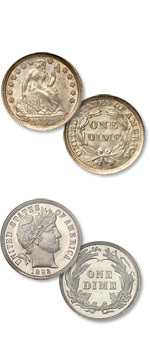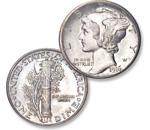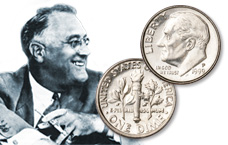U.S. Dimes
Draped Bust Dimes, 1796-1807
Though it may be small in size, America's dime goes back more than 200 years in history, to the early years of our country. First struck in 1796, the original dime design – like other silver coins of the era – bore the Draped Bust design. The obverse depicts a bust of Liberty, her hair tied with a ribbon. For the series' first two years, the reverse showed an eagle perched within a wreath. In 1798, the reverse design was changed to feature the Heraldic Eagle. This design was struck through 1807 – no dimes were issued in 1808.
Capped Bust Dimes, 1809-1837
Then in 1809, the Capped Bust dime was released. Though the obverse was similar to that of the earlier design, Liberty's head now sported a cloth cap. The eagle on the dime's reverse also changed with this new design, now appearing perched on a branch with arrows clutched in its talons. Though this design was issued through 1837, it was not struck every year until 1827.

America's first two dime designs – the Draped Bust, above, and Capped Bust – feature portraits of Liberty.

The Liberty Seated dime, above, and Charles Barber's Liberty Head dime. Both bear the same reverse design.
Liberty Seated Dimes, 1837-1891
First issued in the same year as the final Capped Bust dimes, the Liberty Seated coinage marked a departure from the classic close-up portraiture. This new, more modern design featured a full-length depiction of Liberty. Seated on a rock, she holds a pole in her left hand with a cap on the end. Her right hand supports a shield. On the reverse, the traditional eagle was replaced by an open wreath surrounding the denomination. In 1837 and early 1838, no stars appeared in the obverse design – beginning in 1838 through 1860, 13 stars were added surrounding Liberty. And while the design was modified several more times before it was discontinued, the Liberty Seated coinage continued until 1891.
Barber Dimes, 1892-1916
During the last year of the Liberty Seated dime, the Treasury Department began a search for new coin designs. As a result, in 1892 Charles Barber's Liberty Head design debuted on the dime – as well as the quarter and half dollar. Better known as the Barber dime, the obverse features Liberty's profile, wearing a cap and laurel wreath on her head. The reverse was continued from the previous design – a wreath surrounding the statement of value.
See our Barber dime inventory
Mercury Dimes, 1916-1945
Adolph A. Weinman's highly acclaimed "Mercury" design replaced the Barber dime partway through 1916. Elsie Stevens – wife of poet Wallace Stevens – was used as Weinman's model. His design once again featured the head of Liberty, this time in a winged cap to symbolize freedom of thought. However, following the coin's debut, the public mistook Liberty for the Roman god Mercury. To this day, the coin is best known by that nickname. The reverse also changed, featuring a fasces (bundle of sticks) with an axe blade, and an olive branch in the background. The beloved Mercury dime continued until 1945. That same year marked the passing of President Franklin D. Roosevelt – which prompted another change to America's dime.
See our Mercury dime inventory

The Mercury dime depicts Liberty wearing a winged cap to signify freedom of thought

President Franklin D. Roosevelt is honored on the longest running dime design in U.S. history.
Roosevelt Dimes, 1946-Date
In 1946, the year following Roosevelt's passing, a dime design debuted in his honor. Depicting the profile of America's 32nd president, this tribute was exceptionally fitting because of his longstanding association with the March of Dimes. The reverse shows a torch flanked by branches, with the denomination below and united states of america above. This design continues today, and is the longest running dime design in U.S. history.
See our Roosevelt dime inventory
Read more...

